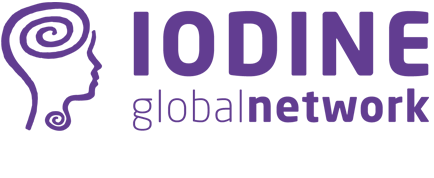Iodine Global Network (IGN)
Sprunglinks/Accesskeys
Zur Startseite (Accesskey 0) Direkt zur Hauptnavigation (Accesskey 1) Direkt zum Inhalt (Accesskey 2) Kontakt (Accesskey 3) Sitemap (Accesskey 4) Suche (Accesskey 5)
DONATE

Zimmermann calls for "new strategies" against IDD
Noting that one-third the world is iodine deficient and 30% of households lack access to iodized salt, ICCIDD board member Dr. Michael B. Zimmermann told the International Thyroid Congress in Paris that new strategies to target iodine supplementation beyond the consensus strategy of universal salt iodization. He called for use of TSH and urinary iodine to assess iodine deficiency in infants and using a throglobulin assay on dried blood spots to identify iodine deficiency.
Endocrine Today reported:
"Zimmermann suggested three novel strategies to target vulnerable groups: newborn thyroid-stimulating hormone; measuring urinary iodine in infants; and using dried blood spot thyroglobulin in children to ensure that the beginning of the life cycle is covered with adequate intake.
"Increasingly, more countries are beginning to conduct careful newborn screening for congenital hypothyroidism and 'maybe it has come time that we use TSH in the field of iodine assessment,' Zimmermann said. Data have shown that serum TSH is increased in iodine-deficient infants during the first few weeks of life. In these instances, newborn TSH may be a sensitive indicator of even mild iodine deficiency in populations, he said. According to WHO, an increase in transient hypothyroidism indicated by TSH levels greater than 5 mU/L in whole blood collected 3 to 4 days after birth in more than 3% of newborns suggests iodine deficiency in a population.
“'As we try to use TSH in infants, we can come up with consistent recommendations about assays and collection methods to get better consistency,' Zimmermann said.
"Second, median urinary iodine is used as an indicator of iodine nutrition in school-aged children, so 'why don’t we think about measuring urinary iodine concentrations in newborns?' he asked. Access to newborns within the first few days of birth is high in many countries.
"Although sample collection may be a challenge in newborns, Zimmermann and colleagues in Switzerland developed a noninvasive pad collection system that uses a feminine hygiene pad, tested to ensure that it is clear of iodine, to aspirate urine from using a syringe. This method of collection is 'completely noninvasive and well accepted.' A study in more than 1,200 children showed that median TSH increased from 77 mcg/L at baseline to 100 mcg/L 1 to 4 days after birth.
"His final recommendation is a thyroglobulin assay for use on dried blood spots as a valuable indicator of iodine deficiency. This method assesses thyroid status, appears to be sensitive to recent changes in iodine intake, and is easy to collect and store. However, it may be a challenge to collect thyroglobulin in many nonindustrialized countries, Zimmermann noted. When he and colleagues studied use of this method in young children, they calculated a reference range of 4 mcg/L to 40 mcg/L. An international reference range and standard reference material for this method would be needed for implementation in newborns."
Endocrine Today reported:
"Zimmermann suggested three novel strategies to target vulnerable groups: newborn thyroid-stimulating hormone; measuring urinary iodine in infants; and using dried blood spot thyroglobulin in children to ensure that the beginning of the life cycle is covered with adequate intake.
"Increasingly, more countries are beginning to conduct careful newborn screening for congenital hypothyroidism and 'maybe it has come time that we use TSH in the field of iodine assessment,' Zimmermann said. Data have shown that serum TSH is increased in iodine-deficient infants during the first few weeks of life. In these instances, newborn TSH may be a sensitive indicator of even mild iodine deficiency in populations, he said. According to WHO, an increase in transient hypothyroidism indicated by TSH levels greater than 5 mU/L in whole blood collected 3 to 4 days after birth in more than 3% of newborns suggests iodine deficiency in a population.
“'As we try to use TSH in infants, we can come up with consistent recommendations about assays and collection methods to get better consistency,' Zimmermann said.
"Second, median urinary iodine is used as an indicator of iodine nutrition in school-aged children, so 'why don’t we think about measuring urinary iodine concentrations in newborns?' he asked. Access to newborns within the first few days of birth is high in many countries.
"Although sample collection may be a challenge in newborns, Zimmermann and colleagues in Switzerland developed a noninvasive pad collection system that uses a feminine hygiene pad, tested to ensure that it is clear of iodine, to aspirate urine from using a syringe. This method of collection is 'completely noninvasive and well accepted.' A study in more than 1,200 children showed that median TSH increased from 77 mcg/L at baseline to 100 mcg/L 1 to 4 days after birth.
"His final recommendation is a thyroglobulin assay for use on dried blood spots as a valuable indicator of iodine deficiency. This method assesses thyroid status, appears to be sensitive to recent changes in iodine intake, and is easy to collect and store. However, it may be a challenge to collect thyroglobulin in many nonindustrialized countries, Zimmermann noted. When he and colleagues studied use of this method in young children, they calculated a reference range of 4 mcg/L to 40 mcg/L. An international reference range and standard reference material for this method would be needed for implementation in newborns."
